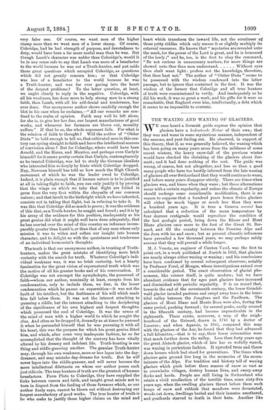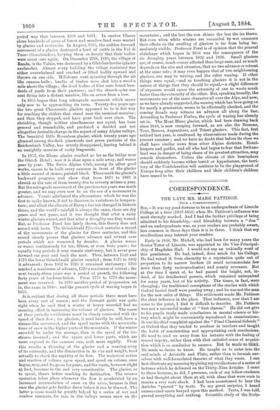THE WAXING AND WANING OF GLACIERS.
WE once heard a Zermatt guide express the opinion that glaciers have a bedeutende Natur of their own ; that they wax and wane in some mysterious manner, independent of the seasons, and past finding out. He observed, in support of
this theory, that if, as was generally believed, the waning which has been going on many years arose from the mildness of some recent winters, the heavy snow-fall of the previous winter would have checked the shrinking of the glaciers about Zer- matt; and it had done nothing of the sort. The guide was
wrong, of course, but not altogether, and less so than a good many people who have too hastily inferred from the late waning of glaciers all over Switzerland that they would continue to wane, and before many years disappear utterly. There are times when glaciers wax, and times when they wane ; but these alternations recur with a certain regularity, and unless the climate of Europe should undergo some considerable modification, there is no reason to suppose that a hundred years hence Swiss glaciers will either be much bigger or much less than they were a hundred years ago. It is true a Genera savant has calculated that a reduction of the mean temperature by four degrees centigrade would reproduce the condition of the last geologic period, bring down the Rhone and Mont Blanc glaciers once more to the foot of the Great St. Ber- nard, and fill the country between the Pennine Alps and the Jura with ice and snow; but as present climatic influences have prevailed a few thousand years, we may perhaps safely assume that they will prevail a while longer.
M. J. Venetz, an engineer of Canton Vaud, was the first to point out, in a work published at Zurich in 1833, that glaciers are nearly always either waxing or waning ; and his conclusions have been confirmed by several subsequent observers, notably by Professor Forel, of Morges, whose investigations extend over a considerable period. The exact observation of glacial phe- nomena, like science itself, is quite modern ; but we have abundant evidence that for ages past glaciers have increased and diminished with periodic regularity. It is on record that, towards the end of the seventeenth century, the lower Grindel- wald glacier invaded pastures and swept away trees in the beau- tiful valley between the Jungfrau and the Faulhorn. The glaciers of Mont Blanc and Monte Rosa were also, during the same period, pushing forward ; for several peaks, easily crossed in the fifteenth century, had become impracticable in the eighteenth. There exists, moreover, a map of the neigh- bourhood of the Grimsel, drawn in 1740 by a doctor of Lucerne; and when Agassiz, in 1845, compared this map with the glaciers of the Aar, he found that they had advanced a full kilometre,—that is to say, their lower extremities were that much further down the valley. Less than forty years ago the great Aletsch glacier, which of late has so wofully waned, was waxing in portentous fashion. It uprooted trees and threw down houses which had stood for generations. The times when glaciers gain ground live long in the memories of the moun- taineers of the Alps. For tradition and history tell of waxing glaciers which push before them masses of snow so vast as to overwhelm villages, destroy human lives, and sweep away flocks and herds. People are still living in Switzerland who retain a vivid recollection of the terrible time, some sixty-five years ago, when the swelling glaciers thrust before them such heaps of snow and rubbish that meadows were devastated, woods cut down, dwellings buried and their inmates smothered, and goatherds starved to death in their huts. Another like period was that between 1608 and 1611. In canton Glarus alone hundreds of acres of forest and meadow-land were wasted by glacier and avalanche. In August, 1585, the sudden forward movement of a glacier destroyed a herd of cattle in the Val di Tnorz (Graubiinden), burying them so deeply that their bodies were never feen again. On December 27th, 1819, the village of Banda, in the Valais, was destroyed by a Gletcher-lawine (glacier avalanche). Almost every building the village contained was either overwhelmed and crushed or lifted bodily upward and thrown on one side. Millstones went spinning through the air like cannon-balls ; baulks of timber were shot into a wood a mile above the village ; the dead bodies of kine were found hun- dreds of yards from their pastures ; and the church-spire was sent flying into a distant meadow, like an arrow from a bow.
In 1855 began that long retrograde movement which seems only now to be approaching its term. Twenty-five years ago the two great Chamounix glaciers appeared to be in fair way for reaching the chalets that stand near the terminal moraine; and then they stopped, and have gone back ever since. The shrinking, though neither simultaneous nor equal, has been general and remarkable, and produced a decided and not altogether desirable change in the aspect of many Alpine valleys. The beautiful little Rosenlane glacier, which twenty years ago gleamed among the dark pinewoods and green pastures of the Reichenbach Valley, has utterly disappeared, leaving behind it an unsightly moraine of rocky fragments.
In 1857, the Rhone glacier reached as far as the bridge near the Gleteh Hotel ; now it is close upon a mile away, and wanes year by year. The Swiss Alpine Club, among its other good works, causes to be built every summer in front of the glacier a little mound of stones, painted black. These mark the glacier'a backward progress, and show that from 1874 to 1883 it shrunk at the rate of from twenty-five to seventy metres a year. But the retrograde movement of the previous ten years was much greater, and we may even now be on the eve of a movement in advance. Venetz attributed the alternations which he was the first to make known, if not to discover, to variations in tempera- ture; and albeit the climate of Europe has not changed in historic times, and the world's rainfall is always the same, there are dry years and wet years, and it was thought that after a rainy winter glaciers waxed, and that after a droughty one they waned. Bat, as Professor Ford has lately shown, this theory does not accord with facts. The Grindelwald Pfaninich contains a record of the movements of the glacier for three centuries, and this record clearly proves that glaciers advance and retreat over periods which are measured by decades. A glacier wanes or waxes continuously for ten, fifteen, or even forty years ; for equally long periods it may remain stationary, but it never goes forward one year and back the next. Thus, between 1540 and 1575 the lower Grindelwald glacier receded ; from 1575 to 1602 it advanced ; from 1602 to 1620 it remained stationary ; 1703 marked a maximum of advance, 1720 a maximum of retreat ; the next twenty-three years was a period of growth, the following forty years of backwardation. From 1776 to 1778 the move- ment was reversed. In 1819 another period of progression set in, the same in 1840; and the present cycle of waning began in 1855.
It is evident that during all these periods there must have been every sort of season ; and the Zermatt guide was quite right when he said that a winter of heavy snowfall had no seeming effect in increasing the volume of glaciers. The cause of their periodic oscillations must be closely connected with the speed of their flow ; for glaciers, it need hardly be said, have a stream-like movement, and the speed varies with the accumula- tions of snow in the higher parts of the mountain. If the winter snowfall be under the average, then is the speed of the ice- 'dream lessened ; and the upper and lower parts, which are more exposed to the summer sun, melt more rapidly. From this results a thinning of the glacier and a wearing-away of its extremity, and the diminution in its size and weight, tend actually to check the rapidity of its flow. The reciprocal action and reaction of volume upon speed, and speed on volume, once begun, may, and do, go on for years, and the waste, however slight at first, becomes in the end very considerable. The glacier, so to speak, thaws before reaching its destination. The reverse operation takes place whenever the flow is accelerated by an increased accumulation of snow on the n6res, because in that case the glacier gets further down before it can be thawed. Ths latter process would be greatly helped by a series of wet and sunless summers, for rain in the valleys means snow on tIr_t
mountains ; and the less the sun shines the less the ice thaws. But even when white winters are succeeded by wet summers their effects on the swelling of glaciers is far from being im- mediately visible. Professor Forel is of opinion that the general shrinkage which began in 1856 was the consequence of the six droughty years between 1832 and 1838. Small glaciers are, of course, much sooner affected than large ones, and so much depends on the size and situation, that no two advance or retreat- at the same rate ; it may even happen that of two neighbouring glaciers, one may be waxing, and the other waning. If other things were equal,—and as touching glaciers it is not in the nature of things that they should be equal,—a slight difference of exposure would cause the extremity of one to waste much faster than the extremity of the other. But, speaking broadly, the movements are of the same character all over the Alps, and now, as we have already suggested, the waning which has been going on for nearly a generation, seems to be effectually checked, and the coming decade may witness an advance all along the line. According to Professor Forbes, the cycle of waxing has already set in. The Mont Blanc glacier, which had been drawing back since 1846, is now creeping forward, as are also the Bossons, Tour, Breuve, Argentieres, and Trient glaciers. This fact, first noticed last year, is confirmed by observations made during the present summer ; and we have no doubt that before its close we shall have similar news from other Alpine districts. Hotel- keepers and guides, and all who had begun to fear that Switzer- land was in danger of being shorn of its greatest attraction, may console themselves. Unless the climate of this hemisphere should suddenly become either torrid or hyperborean, the terri- tory of the Confederation will continue to be the playground of Europe long after their children and their children's children. have ceased to be.



































 Previous page
Previous page